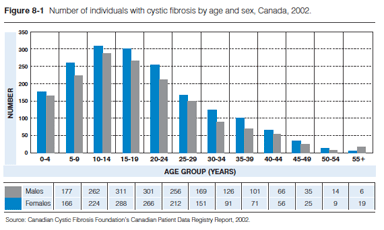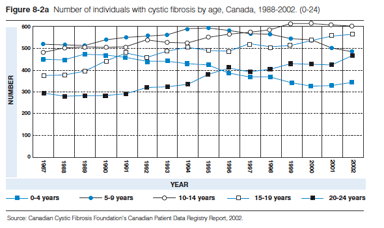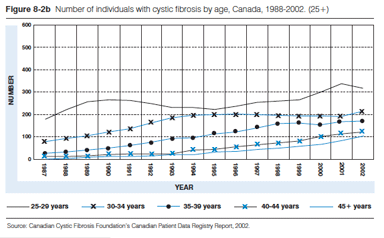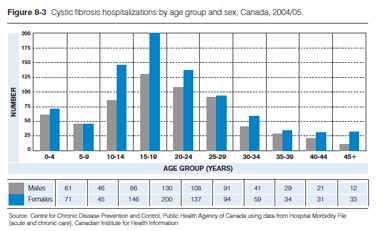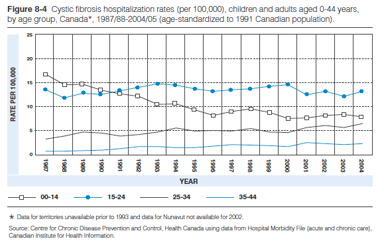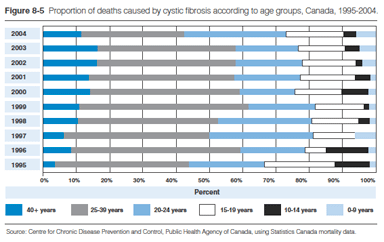Cystic Fibrosis
Introduction
Cystic fibrosis (CF), a chronic fatal respiratory disease, is an autosomal recessive disease, with a carrier rate of 1 in 25.1 Symptoms usually develop in the first few months to first few years of life. Abnormal mucous is produced in the lungs of individuals with cystic fibrosis; it interferes with their breathing and they are more prone to serious lung infections. They are unable to produce adequate pancreatic enzymes for the digestion of food, leading to malnutrition. While many children in the past died before reaching the age of 20, the median age of survival in Canada has reached 37 years.2
Individuals with cystic fibrosis are susceptible to serious lower tract respiratory infections. Usually preceded by viral illnesses, respiratory exacerbations are frequently associated with the common pathogen Staphylococcus aureus and the more serious pathogen Pseudomonas aeruginosa. This increases the rate of destruction of the lung and leads to the development of bronchiectasis.
Successful therapy includes nutritional supplements, pancreatic enzyme supplements, inhaled mucolytics and regular chest physiotherapy. Prompt treatment with antibiotics for respiratory infections is also a critical element of a comprehensive program. More aggressive early treatment with antibiotics and aggressive nutritional programs has helped prolong the lives of individuals with cystic fibrosis and also to improve the quality of their lives.3
Cystic fibrosis exerts a tremendous impact on families. Physiotherapy can take up to two hours per day, and adults must perform this task for children who are not old enough to carry out physiotherapy techniques on themselves. In addition, giving inhaled medication can require up to an hour per day. The cost of medication is a significant expense. And the overall concern that a relative with cystic fibrosis might die at an early age, after serious bouts of illness requiring hospitalization, weighs heavily on a family's emotions.
Incidence/Prevalence
The rate of cystic fibrosis among children born in Canada from 1971 to 1987 was 3.7 per 10,000 births. Recent epidemiological analysis has shown a decrease in the rate of cystic fibrosis in Canada to 2.8 per 10,000 births.4
According to the Canadian Cystic Fibrosis Foundation Patient Data Registry, 3,453 people—48% of whom were older than 18 years—lived with cystic fibrosis in Canada in 2002: 54% were male and 46% were female (Figure 8-1). Approximately 60% of people with cystic fibrosis are diagnosed in the first year of life, 90% by age 10 years.5
Between 1987 and 2002, the number of individuals with cystic fibrosis decreased in the youngest age groups, 0-4 years and 5-9 years, reflecting the decreasing rate of children being born with cystic fibrosis. Increases among the older age groups reflect the improved survival rates (Figure 8-2).
Use of Health Services
Individuals with cystic fibrosis may require hospitalization for aggressive therapy, including intravenous antibiotics during acute exacerbations of symptoms. As the disease progresses, the need for hospitalization increases, as does length of stay.
In 2004, the number of hospitalizations for cystic fibrosis was greatest among individuals in their teen and early adult years. Girls were more likely than boys to be hospitalized, particularly among teens and young adults. The lower number of hospitalizations in the 30+ age groups reflected the smaller number of individuals who survive beyond their 20s (Figure 8-3). Some clinics are using home intravenous antibiotic therapy as an alternative to hospitalization or as a means to decrease the length of stay. However, the long-term benefit of such an approach remains to be demonstrated.
Between 1987 and 2004, hospitalizations for cystic fibrosis decreased among children under the age of 15 years, reflecting improved disease management as well as the declining number of children under age 10 with cystic fibrosis. Hospitalizations among groups 15 years of age and over increased slightly, likely as a result of the increase in the life expectancy (Figure 8-4).
Mortality
While mortality reduces the numbers of individuals with cystic fibrosis above the age of 20, many individuals continue to live with the condition into their 30s. In 2004, there were 52 deaths due to cystic fibrosis in Canada. Between 1995 and 1999, the distribution of the age of death due to cystic fibrosis showed a gradual shift to older age groups. The biggest changes were an increase in deaths over age 40 and a decrease in deaths under age 10. Only seven children who died in the three years from 2002 to 2004 were under the age of 10 (Figure 8-5).
Discussion and Implications
The face of cystic fibrosis has changed radically in the last 20 years. While it was once almost exclusively a child's disease, most individuals with CF are now living into their 20s and 30s, and beyond. Unfortunately, these individuals also experience related health problems, such as male infertility, liver disease and diabetes.
This increase in survival has major implications for the health care system and the community at large. For example, while paediatric respirologists are very familiar with the disease, the number of adult respirologists who have experience in the management of cystic fibrosis patients as they become adults is more limited. Of the 38 cystic fibrosis clinics across Canada, about one-third of which provide care to both children and adults, only 12 are specialized in the care of adults. Since adults with cystic fibrosis will in the near future outnumber children with the disease, the health care system needs to become more responsive to their needs, particularly during the teen-to-adult transition period. It is in this age group that non-respiratory problems, such as diabetes and liver disease, become more troublesome. In addition, more women with CF are staying healthy as they get older, and pregnancy is an emerging management issue. There is also a significant increase in the number of CF patients having children with the use of assisted reproductive techniques.
Families of individuals with cystic fibrosis need significant support to cope with the many stresses imposed by the condition. Education and assistance can help them maintain a normal family life while they cope with the huge physical demands associated with the disease, such as daily physiotherapy and medication. Now that many adults are surviving, flexible and part-time work programs would help them participate more actively in society.
Over the last 50 years, the Canadian Cystic Fibrosis Foundation has established cystic fibrosis clinics across the country to provide a comprehensive range of services to families. The great gains that have been made in treatment and survival are due in a large degree to the work in these clinics. One of their major benefits is the multi-disciplinary team of physicians, nurses, nutritionists and physiotherapists who work closely with families to tailor treatment to individual needs. The challenge now is to ensure that this high quality of service for children continues for adults. The other issue is access. Since most cystic fibrosis clinics are in major cities, children and adults in outlying areas have difficulty achieving full benefit. Eleven of the 38 clinics offer outreach programs and smaller clinics are linked to teaching centres, but more funding is needed to expand the service.
Assistance with the expense of drugs is one very tangible way to provide support to families. Unfortunately, financial support for drugs varies considerably by province. Some provincial programs provide complete support while others have various levels of subsidy. In addition, some provinces provide reimbursement for children's drugs but not for those of adults. As more individuals live into adulthood, this becomes a more influential factor in maintaining a reasonably active and varied life.
Lung transplants are an option during the end stage of cystic fibrosis disease. They have been shown to increase survival and improve quality of life. According to data from the Canadian Institute for Health Information’s Canadian Organ Replacement Register, 66.2% of individuals with lung transplants are alive 5 years after their transplant.6 This option has limitations, however. Transplants are a very resource-intensive therapy and are provided in only a few specialized centres. Many individuals develop graft failure after a few years and require re-transplant in order to remain alive.
Screening of newborns can identify cystic fibrosis in children before symptoms appear. While no treatment exists to prevent the disease, early aggressive treatment can make a difference. Clinical and economic evidence suggest that newborn screening should be adopted as standard of care.7 However, newborn screening for cystic fibrosis requires the support and facilities of CF clinics and access to genetic counselling for families.
1 Fitzsimmons SC. The changing epidemiology of cystic fibrosis. Pediatrics 1993;122:1-9.
2 Canadian Cystic Fibrosis Foundation. Report of the Canadian Patient Data Registry 2002. Toronto: The Foundation; [n.d.];4. Available from: http://www.ccff.ca/pdf/Lay%20CPDR%20ReportE.pdf
3 Morgan MJ et al. Epidemiologic study of cystic fibrosis: design and implementation of a prospective, multicenter, observational study of patients with cystic fibrosis in the U.S. and Canada. Pediatr Pulmonol 1999;28:4:231-41.
4 Dupuis A, Hamilton D, Cole DEC, Corey C. Cystic fibrosis birth rates in Canada: a decreasing trend since the onset of genetic testing. J Pediatr 2005;147:312-5.
5 Dupuis A, Hamilton D, Cole DEC, Corey C.
6 Canadian Institute for Health Information, Treatment of End-Stage Organ Failure in Canada, 1995 to 2004 (2006 Annual Report). Ottawa: the Institute; 2006.
7 Sims E, Mugford M, Clark A, Aitken D, McCormick J, Mehta G, Mehta A. Economic implications of newborn screening for cystic fibrosis: a cost of illness retrospective cohort study. Lancet 2007;369:1187-1195.

